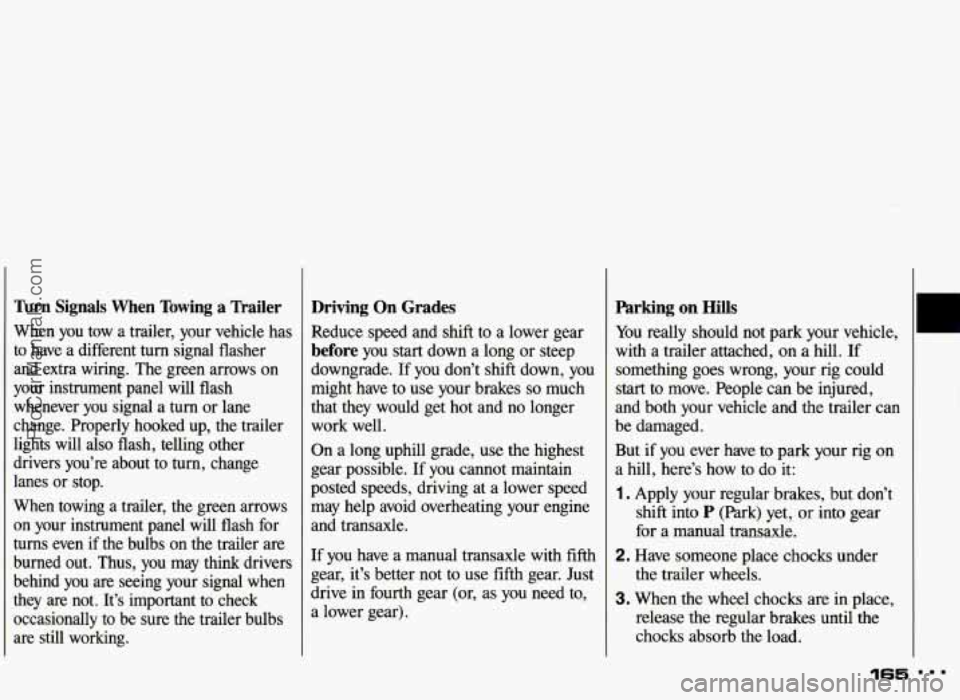Page 61 of 306
Forward Gears (CONT.)
1 (First Gear): This position gives you
even more power (but lower fuel
economy) than
2. You can use it on very
steep hills,
or in deep snow or mud. If
the selector lever is put in 1, the
transaxle won’t shift into
first gear until
the vehicle is going slowly enough. If your front wheels can’t rotate,
don’t
try to drive. This might
happen if you were stuck in very
deep sand or mud or were up
against a solid object. You could
damage your transaxle.
Also, if you stop when going
uphill, don’t hold your vehicle
there with only the accelerator
pedal. This could overheat and
damage the transaxle. Use your
,.brakes
or shift into P (Park) to
:hold your vehicle
in position on a ’ hill.
PN2033.
..
Shiftins the Five-Speed
Manual Transaxle
There are seven different positions:
N Neutral
1 First Gear
2 Second Gear
3 Third Gear
4 Fourth Gear
5 Fifth Gear
R Reverse
888 60
ProCarManuals.com
Page 139 of 306

Your Driving and the Road
Off-Road Recovery
You may find sometime that your right
wheels have dropped off the edge of a
road onto the shoulder while you're
driving.
If the level of the shoulder is only
slightly below the pavement, recovery
should be fairly easy. Ease off the
accelerator and then, if there is nothing
in the way, steer
so that your vehicle
straddles the edge of the pavement. You
can turn the steering wheel up
to 94 turn
until the right front tire contacts the
pavement edge. Then turn your steering
wheel to go straight down the roadway.
If the shoulder appears
to be about four
inches
(100 mm) or more below the
pavement, this difference can cause
problems.
If there is not enough room to pull
entirely onto the shoulder and stop,
then follow the same procedures. But
if
the right front tire scrubs against the
side of the pavement, do
not steer more
sharply. With too much steering angle,
the vehicle may jump back onto the road
with
so much steering input that it
crosses over into the oncoming traffic
before you can bring
it back under
control. Instead, ease off again on the
accelerator and steering input, straddle
the pavement once more, then try again.
Passing
The driver of a vehicle about to pass
another on a two-lane highway waits for
just
the right moment, accelerates,
moves around the vehicle ahead, then
goes back into the right lane again.
A
simple maneuver?
Not necessarily! Passing another vehicle
on a two-lane highway
is a potentially
dangerous move, since the passing
vehicle occupies the same lane as oncoming traffic for several seconds.
A
miscalculation, an error in judgment, or
a brief surrender to frustration or anger
can suddenly put the passing driver face
to face with the worst of all traffic
accidents-the head-on collision.
I.. 138
ProCarManuals.com
Page 166 of 306

Turn Signals When Towing a ’Railer
When you tow a trailer, your vehicle has
to have a different turn signal flasher
and extra wiring. The green arrows on
your instrument panel will flash
whenever you signal a
turn or lane
change. Properly hooked up, the trailer
lights will also flash, telling other drivers you’re about to turn, change
lanes or stop.
When towing a trailer, the green arrows
on your instrument panel will flash for
turns even if the bulbs on the trailer are
burned out. Thus, you may think drivers
behind you are seeing your signal when
they are not. It’s important to check occasionally to be sure the trailer bulbs
are still working.
Driving On Grades
Reduce speed and shift to a lower gear
before you start down a long or steep
downgrade. If you don’t shift down, you
might have to use your brakes
so much
that they would get hot and no longer work well.
On a long uphill grade, use the highest
gear possible. If you cannot maintain
posted speeds, driving at a lower speed
may help avoid overheating your engine
and transaxle.
If you have a manual transaxle with
fifth
gear, it’s better not to use fifth gear. Just
drive in fourth gear (or, as you need to,
a lower gear).
Parking on Hills
You really should not park your vehicle,
with a trailer attached,
on a hill. If
something goes wrong, your rig could
start to move. People can be injured,
and both your vehicle and the trailer can
be damaged.
But if you ever have to park your rig on
a hill, here’s how to do it:
1. Apply your regular brakes, but don’t
shift into
P (Park) yet, or into gear
for a manual transaxle.
2. Have someone place chocks under
the trailer wheels.
3. When the wheel chocks are in place,
release the regular brakes until the chocks absorb the load.
165 DDD
ProCarManuals.com